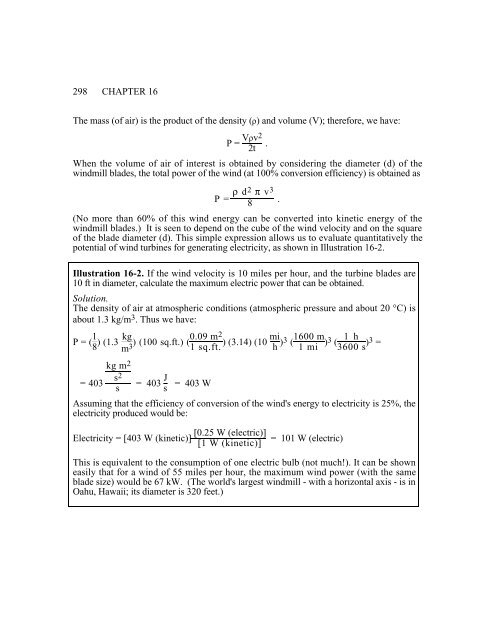Chapter 16 WATER, WIND, BIOMASS AND GEOTHERMAL ENERGY
Chapter 16 WATER, WIND, BIOMASS AND GEOTHERMAL ENERGY
Chapter 16 WATER, WIND, BIOMASS AND GEOTHERMAL ENERGY
You also want an ePaper? Increase the reach of your titles
YUMPU automatically turns print PDFs into web optimized ePapers that Google loves.
298 CHAPTER <strong>16</strong><br />
The mass (of air) is the product of the density (ρ) and volume (V); therefore, we have:<br />
P = Vρv2<br />
2t<br />
.<br />
When the volume of air of interest is obtained by considering the diameter (d) of the<br />
windmill blades, the total power of the wind (at 100% conversion efficiency) is obtained as<br />
P = ρ d2 π v 3<br />
8<br />
.<br />
(No more than 60% of this wind energy can be converted into kinetic energy of the<br />
windmill blades.) It is seen to depend on the cube of the wind velocity and on the square<br />
of the blade diameter (d). This simple expression allows us to evaluate quantitatively the<br />
potential of wind turbines for generating electricity, as shown in Illustration <strong>16</strong>-2.<br />
Illustration <strong>16</strong>-2. If the wind velocity is 10 miles per hour, and the turbine blades are<br />
10 ft in diameter, calculate the maximum electric power that can be obtained.<br />
Solution.<br />
The density of air at atmospheric conditions (atmospheric pressure and about 20 °C) is<br />
about 1.3 kg/m 3 . Thus we have:<br />
P = ( 1 kg<br />
m2 mi<br />
8<br />
) (1.3<br />
m3) (100 sq.ft.) (0.09<br />
1 sq.ft.<br />
) (3.14) (10<br />
h )3 ( <strong>16</strong>00 m<br />
1 mi<br />
) 3 1 h<br />
(<br />
3600 s )3 =<br />
= 403<br />
kg m 2<br />
s 2<br />
s<br />
= 403 J s = 403 W<br />
Assuming that the efficiency of conversion of the wind's energy to electricity is 25%, the<br />
electricity produced would be:<br />
Electricity = [403 W (kinetic)]<br />
[0.25 W (electric)]<br />
[1 W (kinetic)]<br />
= 101 W (electric)<br />
This is equivalent to the consumption of one electric bulb (not much!). It can be shown<br />
easily that for a wind of 55 miles per hour, the maximum wind power (with the same<br />
blade size) would be 67 kW. (The world's largest windmill - with a horizontal axis - is in<br />
Oahu, Hawaii; its diameter is 320 feet.)
















